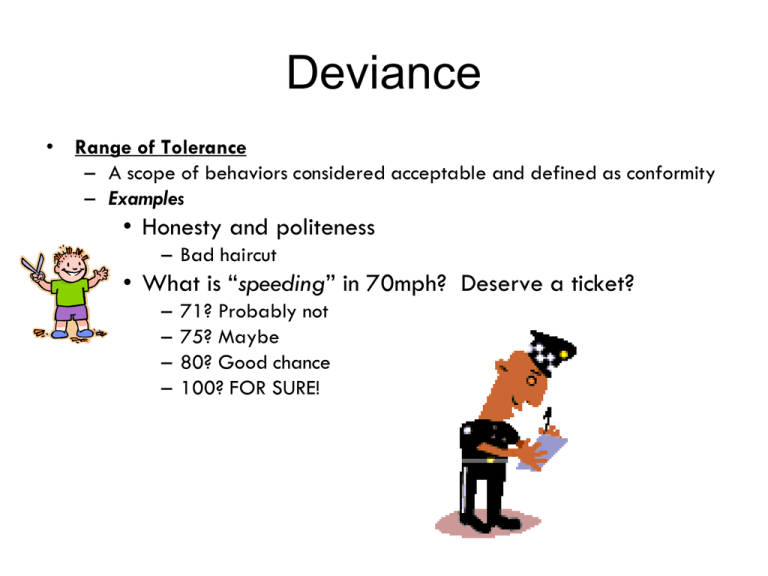Have you ever felt the prickle of guilt after cutting in line? Or the nervous flutter of your stomach before sneaking a peak at a test answer? These are small moments of rebellion, of pushing against the boundaries of what’s considered “normal.” This feeling of transgression, of deviating from the expected, is what we call deviance. It’s a fascinating social phenomenon that shapes our lives, our communities, and the very fabric of society.

Image: study.com
From jaywalking to white-collar crime, deviance exists on a spectrum, and understanding its complexities is crucial. This article delves into the world of deviance, exploring what it is, why it happens, and the diverse ways it manifests in our everyday lives. Prepare to be challenged, to question your own assumptions, and unlock a deeper understanding of the social forces that govern our actions.
The Many Faces of Deviance
Deviance, at its core, is any behavior that violates societal norms. These norms are the unwritten rules, customs, and expectations that guide our interactions and define what is considered acceptable. But what constitutes a violation can fluctuate drastically depending on factors like culture, time period, and social context.
Let’s look at some examples:
- Fashion: In the 1950s, wearing blue jeans in school was considered deviant behavior, signifying rebellion against established norms. Today, jeans are a staple in every closet.
- Relationships: A couple living together without marriage was once deemed deviant, but now it’s become increasingly normalized in many parts of the world.
- Technology: In the digital age, cyberbullying and online harassment present new forms of deviance, reflecting the evolution of our social interactions.
These examples illustrate how deviance is not inherently “wrong” or “right.” Instead, it is a matter of perception and context.
Theories of Deviance: Unraveling the Why
Numerous sociological theories attempt to explain why individuals engage in deviant behavior. Here are a few prominent ones:
- Strain Theory: This theory suggests that deviance arises when individuals experience a strain or a “gap” between their aspirations and the legitimate means available to achieve them. If someone feels they cannot succeed through conventional methods, they may turn to deviant acts to reach their goals.
- Social Control Theory: This theory posits that deviance occurs when individuals’ social bonds are weak or compromised. When people feel connected to their community, family, and institutions, they are less likely to engage in deviant behavior.
- Labeling Theory: This theory highlights the power of societal labels and the role they play in shaping people’s identities and behaviors. If someone is labeled as a deviant, they may internalize this label and act accordingly, even if they didn’t previously engage in deviant behavior.
Deviance in Action: Real-world Examples
Deviance manifests in countless ways, ranging from minor transgressions to serious crimes. Here are a few examples that illustrate the variety of forms it can take:
- Everyday Deviance: These are common violations that are often overlooked or tolerated, such as jaywalking, exceeding the speed limit, or downloading music illegally.
- White-Collar Crime: This refers to illegal acts committed by people of high social status, such as fraud, embezzlement, or tax evasion.
- Corporate Deviance: This involves unethical behavior by organizations, such as environmental pollution, price fixing, or unfair labor practices.
- Social Movements: Historically, social movements have often been labeled as deviant, as they challenge existing power structures and norms. Examples of this include the Civil Rights Movement, the Women’s Suffrage Movement, and the LGBTQ+ rights movement.

Image: studylib.net
Recognizing the Importance of Deviance
While deviance can sometimes have negative consequences, it also plays a crucial role in society. Here’s why:
- Social Change: Deviance often serves as a catalyst for social change, challenging existing norms and pushing for greater equality and justice.
- Social Awareness: Deviant acts can make society aware of issues that are often hidden or ignored. For example, civil disobedience can highlight injustices in the legal system or expose corruption within institutions.
- Social Control: Deviance can act as a form of social control, reminding individuals of the consequences of violating societal norms.
Navigating Deviance: A Thoughtful Approach
Understanding deviance requires a nuanced and critical perspective. It’s important to remember that:
- Context Matters: What is considered deviant in one culture or time period might be acceptable in another.
- Power Dynamics: Deviance is often linked to power dynamics, with those in marginalized groups being more likely to be labeled as deviant for the same actions committed by those in privileged positions.
- Personal Responsibility: While societal factors play a role in deviance, individuals still bear responsibility for their actions.
Examples Of Deviance
Navigating the Gray Areas
We all make choices, and some of those choices might be considered deviant. It’s crucial to think critically about the context, the motivations, and the potential consequences of our actions. As we navigate the gray areas of deviance, we must strive for empathy, understanding, and a commitment to fostering a more just and equitable society. By challenging our assumptions and engaging in critical dialogue, we can learn to live more thoughtfully within the dynamic and ever-evolving landscape of social norms.





